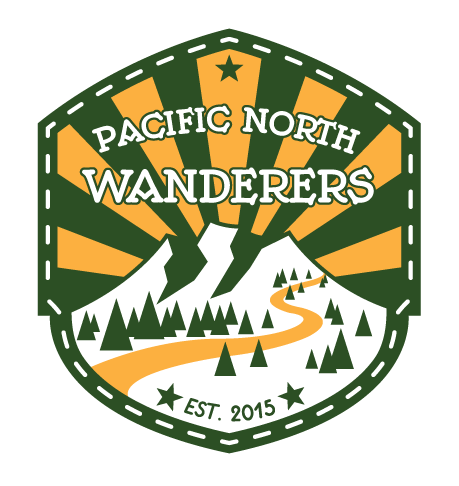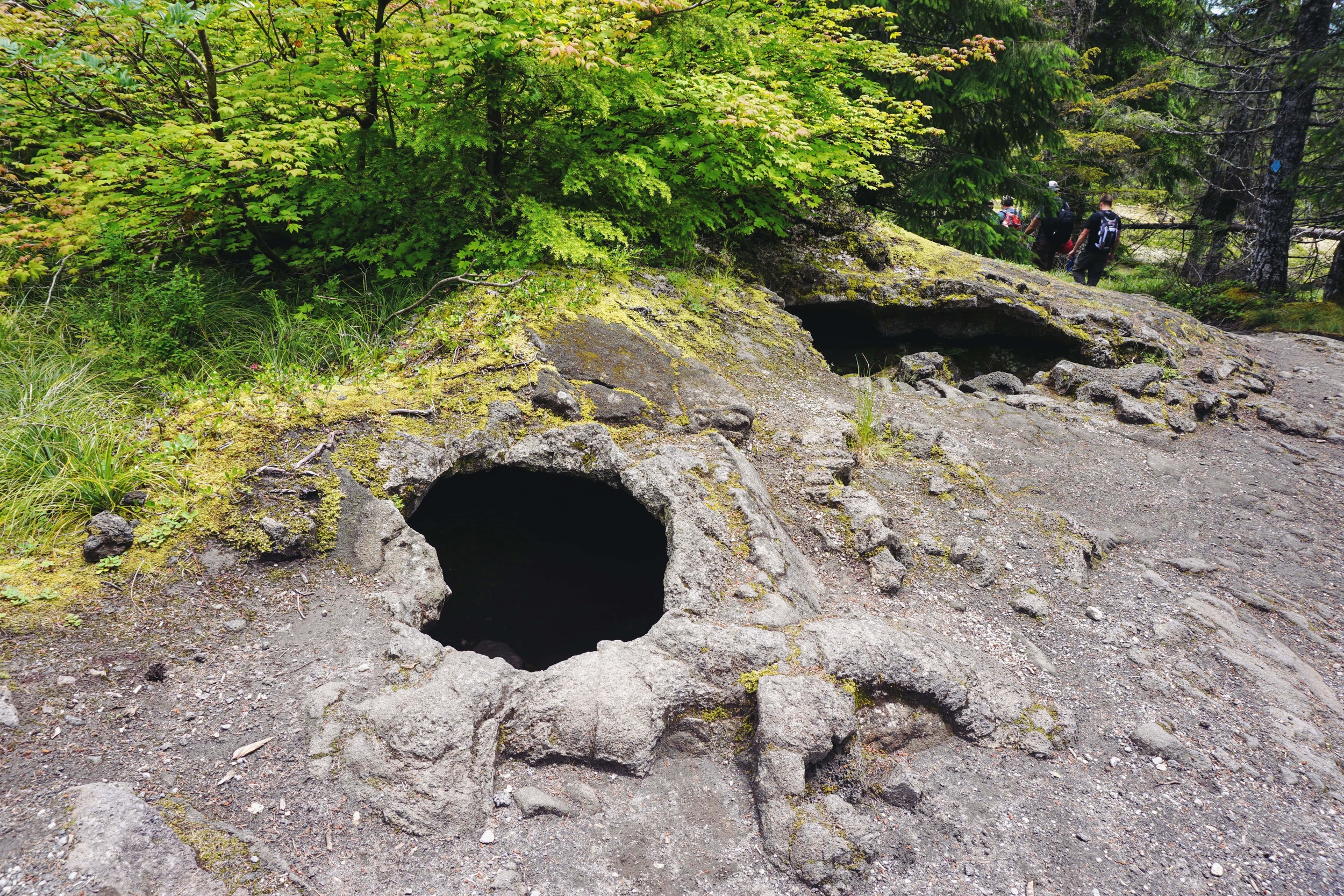Exploring Ape Cave
The Third Longest Lava Tube In North America
A 13,042' long lava tube lies beneath the Gifford Pinchot National Forest, south of Mt. Saint Helens. It was created by a rare eruption that sent fluid basaltic lava flowing down the southern flank of the volcano for months, if not a year. The top of this lava flow hardened, forming the ground today that rests atop the cave, while the lava was free to remain flowing under it. This is the third longest lava tube in North America and was created during an eruption roughly 2,000 years ago. The named Ape Cave, which also goes by Ape Caves, is a popular attraction with visitors filling both parking lots during the summer weekends.
“The cave you fear to enter holds the treasure you seek.”
The Apes That Once Explored This Cave
The name is just as intriguing as the cave itself. It's what catches the eyes while browsing through a list of hikes when trying to find your next adventure. At least, that's how it happened for us. The first people to have explored the cave consisted of a scout troop in the early 1950s, led by Harry Reese. The cave was named in honor of that troop's sponsor, the St. Helens Apes. And it's believed that the sponsor's name originated from either "brush apes", which was what foresters were once referred to as, or from the widely known legend that goes by the name of Bigfoot.
We like to believe that the name came from a Bigfoot sighting because hey, we love hearing of legends, mythology, and stories of lore! One such story is I Fought the Apemen of Mount St. Helens, WA, which details a Bigfoot attack on five miners in 1924 in this region. We'll let you come to your own conclusion of how this two mile long cave was named.
A Journey Through the Center of the Earth
Well, not quite the center, but it did feel like it :-p
During the summer months the visitors center, aptly named Ape's Headquarters, is open daily and it provides the typical souvenirs but also lantern rentals if needed ($5). We took a quick glance in before hitting the trail but it was a very small room with a lot of guests already occupying it. So off we went.
A short trail leads to the main entrance of both lower and upper caves. Here there are informational boards detailing the history of the cave and how it was formed. A park employee, or volunteer, also had a small booth setup and was speaking about White-Nose Syndrome which has been killing millions of bats throughout the country, however the syndrome has yet to be discovered at this particular cave. And finally, there's Ape Cave Trail which leads north for 1.75 miles to the upper entrance. We took the trail north.
Apparently the majority of people who who walk the cave do so from a south to north direction, entering at the main entrance we had just passed. The trail, as well as the cave below, gain elevation while hiking north. The gain is not much, and it's not the real reason why most choose the opposite route. More on that later.
As we hiked the trail we noticed lava rock flows, piles of large boulders, blueberry plants, a handful of smaller sized caves in the ground (potentially dangerous for children that could fall into these), and many people passing by us in the opposite direction. The hike didn't take long and we eventually reached the north entrance which was in the bottom of a large cratered out type of hole.
There's a permanent ladder attached here that drops down to the dark, chilled cave floor. The cooler temperature was a welcome change on this warm day! Be careful while descending, the ladder starts out at a 45 degree angle and then abruptly moves to about an 80 degree angle. Be mindful of your steps and take your time so you don't lose your footing and fall.
Once on the cave bottom you can head in a northwest direction for about 500' or so which will bring you to the northern end. An enormous pile of large boulders are all bunched up here. Take your time and look around to see the cave walls with their sparkly bacterial mats shining about, and the upper "railroad tracks" on either side. Now's a good time to make sure all your gear is working and to accustom your footing before moving on.
Heading south was quite the journey. More water in the form of puddles and drips, rocks that look like they fell from space, an opening revealing the sky above, multiple sets of boulder piles to scramble over, slime on the wall that you're not supposed to touch, and two walls/ledges that you must descend. One of them, at 8 feet tall, is a bit tricky as there aren't many options to place your feet. However, it does provide a flat rope to hang onto, and this is also a good example of where gloves would come in handy. The reason for starting the hike in the opposite direction is that instead of descending down these walls/ledges, you'd be climbing up them. Same with the rock piles. For most people, climbing up is usually always easier than climbing down. With that being said, we managed pretty well here.
Like we mentioned earlier, it was a busy day here. But that didn't prevent us from having moments in sections of the cave all to ourselves. It's sort of eerie when you're alone in the dark, not able to hear the sounds of others, and not knowing much of what to expect next. Those moments didn't last long, others passing in the opposite direction came by often. The shape of the tunnel and the contouring of the walls looks like some abandoned subway system. We didn't really see any insects, but we did see a mouse while rock hopping our way over one of the boulder piles.
As you're nearing the main entrance you'll approach a large open area, 88 feet wide, which is referred to as "The Big Room". This was a pretty spectacular site. After that you'll see the staircase, which you'll want to pass by for now and continue on south into the lower cave. There are really no obstacles here aside from the numerous puddles. This one was also busier as many families with children choose to only do this portion. Although, the upper cave did have its fair share of younger children as well.
Once you reach the end of this cave the ceiling starts to taper lower and lower, until you're forced to get on your hands and knees in order to go further. And again, even lower to the point where you have to begin low crawling. Once we got to the low crawl point we turned back, we didn't feel like having sand in our clothes for the 3.5 hour drive home. We're not sure how much further it goes on but the map does indicate that the cave ends in this general area. So it's a walk back to the stairs, a quick jog up them, and you're out.
Final Thoughts of Ape Cave
Not for the weak ankled or the claustrophobic! This fascinating, natural underworld is a thrill to explore. If you're okay with the darkness and the dampness and don't mind scrambling up and down boulder piles, this place is begging you to visit! Bring good, bright light sources, a light jacket, gloves, and good footwear and adventure on!
Hey, we appreciate your readership! If you're in the market for new gear and would be willing to make your purchase through our Amazon link, we might get a small commission out of it. No additional cost to you and maybe a little something for us!
Thank you for your support!
Have you been to Ape Cave or are you planning on going? Let us know in the comments section below.
Helpful Information for Hiking Ape Cave
Coordinates: 46°06'34.2"N 122°12'40.9"W
Distance: Upper & lower cave total length is 2.47 miles.
Elevation Gain: 350'
Highest Point: 2,450'
Time Spent: 3 hrs.
Pass: $5/day or Recreation Pass. Northwest Forest, Interagency, and Local Passes accepted.
What To Bring: Headlamp, flashlight, extra batteries, warm clothing, gloves, water
Not allowed in cave: Pets, food
Happy Explorations!
Postcards from Ape's Headquarters!
Thanks for reading through to the end of our story! Be one of the first 5 people to leave a comment and we'll send you 1 of 5 postcards we purchased from Ape's Headquarters (must be a U.S. postal address). Contact us with your address after you leave your comment and the postcard will be shipped right away!
Follow along on our wanderings around the Pacific Northwest.
The only thing better would be being there yourself!
Subscribe to Our Newsletter























